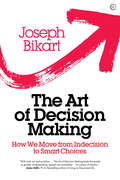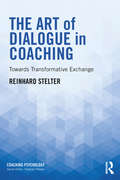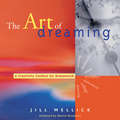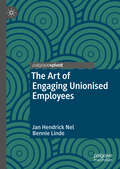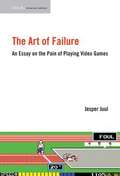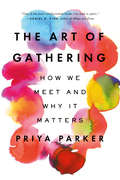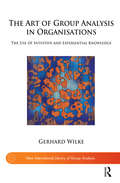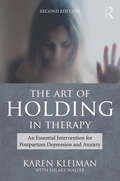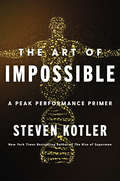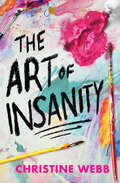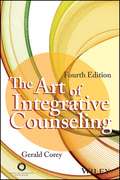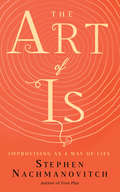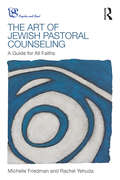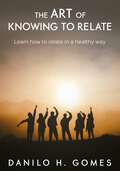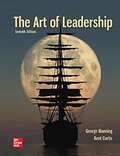- Table View
- List View
The Art of Decision Making: How we Move from Indecision to Smart Choices
by Joseph BikartDrawing from different 'fields' such as philosophy, psychology, literature, and theology, Joseph Bikart uses decades of experience as a business coach for senior executives around the globe to explore how and why we make the decisions we do.What is it that makes some of us better - or worse - than others at committing to a choice? What are the forces that hold us back, and how can we successfully overcome them? Every facet of our lives depends on the decisions we make. Yet, how often do we pause to reflect on our ability to make the best and smartest choices? The key is how we confront and refine the decision making process. Joseph Bikart explores the intricacies of decision making, challenging us to understand why we make the choices we do. He explores how the true power of decisions, especially the toughest among them, help us to face our fears and may in turn change how we think about ourselves. The book is broken into four clear parts and punctuated with short practical essays Bikart presents a lively and compelling exploration of the process of decision making covering; Indecision, indecision - what makes us indecisive? What holds us back and why? Where Art Thou? How and where we get stuck and the importance of relaxing one's grip. The Momentum of Decisiveness - Keeping our focus and proactivity. The Deciding Mind - making our smartest choices. Drawing from such different fields as philosophy, psychology, neurology, literature, art history and theology, we are taken on a journey from the depths of procrastination to the elation of decision making. Presenting a fresh perspective on what to do at the proverbial fork in the road, Bikart's unique philosophy is insightful, thought provoking, and potentially life-changing.
The Art of Dialogue in Coaching: Towards Transformative Exchange (Coaching Psychology)
by Reinhard StelterIn The Art of Dialogue in Coaching, Reinhard Stelter invites readers to engage in transformative and fruitful dialogues in everyday working life, and provides the theory and tools for them to be able to do so. Presented in three parts, the book provides a complete overview of the importance of dialogue and how it can be utilised. Part I, Theoretical basis, examines third-generation coaching as a collaborative dialogue form, the societal context of the coaching process and the concept of identity in modern society. Part II, Basic themes of fruitful dialogue, examines meaning-making, value and the narrative perspective, and their significance in creating a new dialogue culture. Finally, Part III, Reflections on dialogue practice, explores the art of being a supporting dialogue guide, drawing on a number of theoretical perspectives and focusing on developing relational competencies. Stelter emphasises that taking the time to linger opens new possibilities for fundamental self-insight, and clearly explains how dialogue provides us with a framework for acting in the world with personal integrity. The Art of Dialogue in Coaching will be an essential guide for coaches in practice and in training, coaching psychologists and professionals with a coaching role, including mentors, consultants and leaders. In particular, it will appeal to those looking to conduct dialogue as an art form, enhancing their work as a co-creative and collaborative guide.
The Art of Dreaming: A Creativity Toolbox for Dreamwork
by Jill MellickA clinical psychologist offers a revolutionary approach to dream analysis—through artistic expression: &“A jewel.&”—Robert A. Johnson, author of Inner WorkDream books that guide readers to work with their dreams invariably ask them to write their dreams down, or perhaps record them. The Art of Dreaming stands apart from all other dream books in that it invites readers to work with their dreams in whatever medium is most natural and beneficial to them. For some, that might in fact be writing or talking, but for others it might be drawing or painting or working in clay or dancing or dramatizing or recreating movement or maskmaking or working in multimedia or creating poetry. This book is a beautiful integration of dreaming and creativity, one that takes readers to a place where they can work with both the essential and deep messages from their dreams.The book makes use of illustrative icons to clearly indicate to readers the art medium for each activity, enabling them to go directly to the type of activity that most appeals to them.&“Mellick, a clinical psychologist and registered expressive arts therapist, details a multitude of ways to decipher your dreams…describes visual, vocal, and theatrical methods for cracking imagery.&”—Library Journal
The Art of Engaging Unionised Employees
by Bennie Linde Jan Hendrick NelThis book introduces a framework to assist human resource practitioners and organisations embrace strategies that will drive high engagement levels within organisations with a union presence. The authors address established definitions of engagement and how they have been conceptualised in academic and practitioners’ literature, before exploring and unpacking circumstances that influence levels of engagement amongst employees in a unionised environment. In doing so, the framework introduced elaborates on approaches and interventions with the greatest potential to create, improve, and embed high levels of engagement within the unionised work environment.
The Art of Experience: The Theatre of Marina Carr and Contemporary Psychology
by Dagmara GizłoThe Art of Experience provides an interdisciplinary analysis of selected plays from Ireland’s premier female playwright, Marina Carr. Dagmara Gizło explores the transformative impact of a theatrical experience in which interdisciplinary boundaries must be crossed. This book demonstrates that theatre is therapeutic and therapy is theatrical. The role of emotions, cognitions, and empathy in the theatrical experience is investigated throughout. Dagmara Gizło utilises the methodological tools stemming from modern empirically grounded psychology (such as cognitive-behavioural therapy or CBT) to the study of theatre’s transformative potential. This book will be of great interest to students and scholars of theatre, performance, and literature, and will be a fascinating read for those at the intersection of cognitive studies and the humanities.
The Art of Failure
by Jesper JuulWe may think of video games as being "fun," but in The Art of Failure, Jesper Juul claims that this is almost entirely mistaken. When we play video games, our facial expressions are rarely those of happiness or bliss. Instead, we frown, grimace, and shout in frustration as we lose, or die, or fail to advance to the next level. Humans may have a fundamental desire to succeed and feel competent, but game players choose to engage in an activity in which they are nearly certain to fail and feel incompetent. So why do we play video games even though they make us unhappy? Juul examines this paradox. In video games, as in tragic works of art, literature, theater, and cinema, it seems that we want to experience unpleasantness even if we also dislike it. Reader or audience reaction to tragedy is often explained as catharsis, as a purging of negative emotions. But, Juul points out, this doesn't seem to be the case for video game players. Games do not purge us of unpleasant emotions; they produce them in the first place. What, then, does failure in video game playing do? Juul argues that failure in a game is unique in that when you fail in a game, you (not a character) are in some way inadequate. Yet games also motivate us to play more, in order to escape that inadequacy, and the feeling of escaping failure (often by improving skills) is a central enjoyment of games. Games, writes Juul, are the art of failure: the singular art form that sets us up for failure and allows us to experience it and experiment with it. The Art of Failure is essential reading for anyone interested in video games, whether as entertainment, art, or education.
The Art of Fear: Why Conquering Fear Won't Work and What to Do Instead
by Kristen UlmerThe former professional extreme skier “unpacks this misunderstood emotion and lays out strategies for experiencing fear in an empowering way” (Parade).We all feel fear. Yet we are often taught to ignore it, overcome it, push past it. But to what benefit? This is the essential question that guides Kristen Ulmer’s remarkable exploration of our most misunderstood emotion in The Art of Fear.Once recognized as the best extreme skier in the world (an honor she held for twelve years), Ulmer knows fear well. In this conversation-changing book, she argues that fear is not here to cause us problems—and that in fact, the only true issue we face with fear is our misguided reaction to it (not the fear itself).Rebuilding our experience with fear from the ground up, Ulmer starts by exploring why we’ve come to view it as a negative. From here, she unpacks fear and shows it to be just one of 10,000 voices that make up our reality, here to help us come alive alongside joy, love, and gratitude. Introducing a mindfulness tool called “Shift,” Ulmer teaches readers how to experience fear in a simpler, more authentic way, transforming our relationship with this emotion from that of a draining battle into one that’s in line with our true nature.Influenced by Ulmer’s own complicated relationship with fear and her over fifty years as a mindset facilitator, The Art of Fear will reconstruct the way we react to and experience fear—empowering us to easily and permanently address the underlying cause of our fear-based problems, and setting us on course to live a happier, more expansive future.
The Art of Flourishing
by Jeffrey B. RubinWe all want more love in our lives, especially when the world requires more from us every day. Lasting intimacy--a close and enduring relationship with someone we love who cherishes us--is an indispensable source of strength, resilience, and hope, one that we especially turn to in challenging times. But too often being in an intimate relationship means we have to compromise--or lose--vital aspects of ourselves. How can we avoid sacrificing our own self-care to get the love we want?In this original, surprising, and deeply revealing exploration of the self and relationships, Dr. Jeffrey Rubin brings the art of flourishing to life. The idea is startlingly simple: self-care is the foundation of intimacy, and intimacy is the culmination of self-care. The Art of Flourishing provides the reader with the tools necessary to thrive, to live a life of meaning, passion, and fulfillment.An expert on both Eastern meditative and Western psychotherapeutic traditions, Dr. Rubin draws on the best practices of each to create a new and accessible path to living authentically. His unique synthesis provides a remarkably lucid guide for handling our emotions wisely, discovering our purpose, and uncovering barriers to intimacy--the hidden emotional weeds that kill passion, such as conflicts over communication and power, boundaries and sexuality. Drawing from case examples and personal experiences, Rubin explains how to remove these obstacles to nurture empathy and mutual respect. Creating and cultivating a garden of love enables us to grow as individuals and nourish our connections with others. It widens our horizon of possibility, deepens our humanity, and helps us flourish, which is a priceless gift to the world.From the Hardcover edition.
The Art of Forgetting
by Ivan IzquierdoHow do we forget? Why do we need to forget? This book intends to answer to these and other questions. It aims to demonstrate that each one is who it is due to their own memories. Thus, distinguish between the information we should keep from those we should forget is an difficult art. In this book, the author discusses about the different types of memory, the main types of forgetting (avoidance, extinction and repression), their brain areas and their mechanisms. In this sense, the art of forgetting, or the art of do not saturate our memory mechanisms, is something innate, that benefits us anonymously, keeping us from sinking amidst our own memories. The essays that compose this book go through several aspects, since individuals to societies' memory. By the end of the book, the reader will be able to understand that we forget to be able to think, to live and to survive.
The Art of Gathering: How We Meet and Why It Matters
by Priya Parker"Hosts of all kinds, this is a must-read!" --Chris Anderson, owner and curator of TEDA bold new approach to how we gather that will transform the ways we spend our time together--at work, at home, in our communities, and beyond.In The Art of Gathering, Priya Parker argues that the gatherings in our lives are lackluster and unproductive--which they don't have to be. We rely too much on routine and the conventions of gatherings when we should focus on distinctiveness and the people involved. At a time when coming together is more important than ever, Parker sets forth a human-centered approach to gathering that will help everyone create meaningful, memorable experiences, large and small, for work and for play.Drawing on her expertise as a facilitator of high-powered gatherings around the world, Parker takes us inside events of all kinds to show what works, what doesn't, and why. She investigates a wide array of gatherings--conferences, meetings, a courtroom, a flash-mob party, an Arab-Israeli summer camp--and explains how simple, specific changes can invigorate any group experience.The result is a book that's both journey and guide, full of exciting ideas with real-world applications. The Art of Gathering will forever alter the way you look at your next meeting, industry conference, dinner party, and backyard barbecue--and how you host and attend them.
The Art of Grief: The Use of Expressive Arts in a Grief Support Group (Series in Death, Dying, and Bereavement)
by J. Earl RogersArt and other expressive therapies are increasingly used in grief counseling, not only among children and adolescents, but throughout the developmental spectrum. Creative activities are commonly used in group and individual psychotherapy programs, but it is only relatively recently that these expressive modalities have been employed within the context of clinical grief work in structured settings. These forms of nonverbal communication are often more natural ways to express thoughts and feelings that are difficult to discuss, particularly when it comes to issues surrounding grief and loss. Packed with pictures and instructional detail, this book includes an eight-session curriculum for use with grief support groups as well as alternative modalities of grief art therapy.
The Art of Group Analysis in Organisations: The Use of Intuitive and Experiential Knowledge (The New International Library of Group Analysis)
by Gerhard WilkeLeaders, teams and organisational consultants are faced with a situation of permanent transitions. The current world of organisations is full of beginnings and incomplete endings. The author assumes that the endless re-structuring of living networks of relationships in organisations generates, over time, post-traumatic stress disorder in individuals, groups and the whole system. The book deals with the paradox that continuity is the most important factor in change and that leadership alone solves very little. Even the most heroic figure flounders without the help of the various groups in the organisation, which make things work. The author reflects on his practice of developing teams, professionals and organisations with an approach rooted in group analysis and social anthropology. The dominant way of looking at performance, motivation and leadership focuses on individuals and fails to take into account how we work together, how we fail to co-operate and how inter-dependent we are.
The Art of Hard Conversations: Biblical Tools for the Tough Talks That Matter
by Lori Stanley RoeleveldYour next conversation could impact someone's life foreverHard conversations challenge everyone. Some people make every effort to avoid them altogether; others dive in enthusiastically, damaging relationships in the process. A solid middle ground is difficult to find--especially for those who want to make sure they're following a biblical model for these tough encounters.Lori Roeleveld firmly believes that the dialogues everyday Christians delay are often the very channels God wants to use to deepen relationships and transform lives. And she is eager to address the challenges they pose and to guide readers to meaningful conversations that rely on the wisdom of the Bible rather than the world.In The Art of Hard Conversations, Roeleveld provides motivation, inspiration, and practical, readily applied skills to make those tricky talks more effective. Through funny, vulnerable personal stories, sound biblical teaching, and sections of tips and assignments to practice, the principles here are guaranteed to increase the confidence and competence of Christians in discussing sensitive topics of every kind.
The Art of Holding in Therapy: An Essential Intervention for Postpartum Depression and Anxiety
by Karen Kleiman Hilary WallerWritten by a pioneer in the field, this second edition provides updated skill-building tools and a more developed, comprehensive understanding of how therapists can use the holding approach when treating perinatal distress.First conceptualized by D.W. Winnicott, the “holding” approach refers to a therapist’s capacity to respond to postpartum distress in a way that facilitates an immediate and successful therapeutic alliance. This model has continued to advance, and this newly updated edition will help readers learn how to contain high levels of agitation, fear, and panic in a way that cultivates trust and the early stages of connectedness. Filled with vignettes throughout, this book includes chapters on what holding is, how to prepare using this model, the emotions specific to postpartum mothers, the essential holding elements, and the practice of holding. This book uniquely addresses the needs of therapists who may find themselves confronting, struggling with, or recovering from their own reproductively related journeys, with chapters discussing the professional’s identity, clinical challenges, and a new chapter on cultural humility.This book is essential reading for all of those in the perinatal mental health community, such as therapists, social workers, and clinicians.
The Art of Holding in Therapy: An Essential Intervention for Postpartum Depression and Anxiety
by Karen KleimanFirst conceptualized by D.W. Winnicott, holding in this book refers to a therapist’s capacity to respond to postpartum distress in a way that facilitates an immediate and successful therapeutic alliance. Readers will learn how to contain high levels of agitation, fear, and panic in a way that cultivates trust and the early stages of connectedness. Also addressed through vignettes are personality types that make holding difficult, styles of ineffective holding, and how to modify holding techniques to accommodate the individual woman. A must-read for postpartum professionals, the techniques learned in this book will help clients achieve meaningful and enduring recovery.
The Art of Impossible: A Peak Performance Primer
by Steven KotlerNew York Times BestsellerBestselling author and peak performance expert Steven Kotler decodes the secrets of those elite performers—athletes, artists, scientists, CEOs and more—who have changed our definition of the possible, teaching us how we too can stretch far beyond our capabilities, making impossible dreams much more attainable for all of us.What does it take to accomplish the impossible? What does it take to shatter our limitations, exceed our expectations, and turn our biggest dreams into our most recent achievements? We are capable of so much more than we know—that’s the message at the core of The Art of Impossible. Building upon cutting-edge neuroscience and over twenty years of research, bestselling author, peak performance expert and Executive Director of the Flow Research Collective, Steven Kotler lays out a blueprint for extreme performance improvement. If you want to aim high, here is the playbook to make it happen!Inspirational and aspirational, pragmatic and accessible, The Art of Impossible is a life-changing experience disguised as a how-to manual for peak performance that anyone can use to shoot for the stars . . . space-suit, not included.
The Art of Insanity
by Christine WebbHigh schooler Natalie Cordova has just been diagnosed with Bipolar disorder. Her mom insists she keep it secret.Putting up a front and hiding her mental illness from her classmates is going to be the hardest thing high schooler Natalie Cordova has ever done. It&’s her senior year, and she&’s just been selected to present her artwork at a prestigious show. With the stress of performing on her shoulders, it doesn&’t help when Natalie notices a boy who makes her heart leap. And then there&’s fellow student Ella, who confronts Natalie about her summer car &“accident&” and pressures her into caring for the world&’s ugliest dog. Now Natalie finds herself juggling all kinds of feels and responsibilities. Surely her newly prescribed medication is to blame for the funk she finds herself in. But as Natalie&’s plan to self-treat unravels, so does the perfect façade she&’s been painting for everyone else. Written from experience, this heartfelt and candid contemporary YA novel explores the stigma surrounding mental illness and offers an uplifting narrative of resilience.
The Art of Inspired Living: Coach Yourself with Positive Psychology (Professional Coaching Ser.)
by Sarah CorrieThis book is about learning to live your life more fully. It doesn't promise you abundant joy, the relationship of your dreams, untold riches or miracle cures. But what it does promise you is a comprehensive programme of personal development, change and growth that is highly effective. This coaching programme has been developed with two audiences in mind. The first is those who wish to coach themselves to success and who are confident about achieving positive results once they know the basic framework. The second audience is those who work as coaches and who are looking for new ideas and frameworks that they can build into their existing practice. Whatever has drawn you to this book - whether it is because you feel you have reached a crossroads in your life, because you have a very specific goal in mind, or because you are a coach looking for some fresh ideas - there is something here for you.
The Art of Integrative Counseling
by Gerald CoreyUseful as a supplemental text in advanced theories and practicum courses, this fourth edition discusses the key concepts and techniques from many contemporary theories and how to develop an integrative approach to the counseling process to better meet individual client needs. Dr. Corey introduces the techniques that he draws from in his own integrative approach to counseling using a wide variety of case examples with diverse clients. Topics covered include assessing presenting issues; developing a productive working alliance; establishing therapeutic goals; understanding and addressing diversity; working with resistant clients; using evidence-based practice in cognitive, emotive, and behavioral work with clients; dealing with transference and countertransference; and incorporating trends in integrative therapies. To encourage active learning, reflective exercises throughout the text provide readers with opportunities to put themselves in the role of therapist and client.
The Art of Interpretation: Deconstruction and New Beginnning in the Psychoanalytic Process (The International Psychoanalytical Association Psychoanalytic Ideas and Applications Series)
by Wolfgang LochThis book examines Freud's use and definition of interpretation as a therapeutic tool as well as views it from the philosophical perspective of meaning and its definition. In addition, it examines the later developments made by Klein and Bion.
The Art of Is: Improvising as a Way of Life
by Stephen NachmanovitchA MASTERFUL BOOK ABOUT BREATHING LIFE INTO ART AND ART INTO LIFE &“Stephen Nachmanovitch&’s The Art of Is is a philosophical meditation on living, living fully, living in the present. To the author, an improvisation is a co-creation that arises out of listening and mutual attentiveness, out of a universal bond of sharing that connects all humanity. It is a product of the nervous system, bigger than the brain and bigger than the body; it is a once-in-a-lifetime encounter, unprecedented and unrepeatable. Drawing from the wisdom of the ages, The Art of Is not only gives the reader an inside view of the states of mind that give rise to improvisation, it is also a celebration of the power of the human spirit, which — when exercised with love, immense patience, and discipline — is an antidote to hate.&” — Yo-Yo Ma, cellist
The Art of Jewish Pastoral Counseling: A Guide for All Faiths (Psyche and Soul)
by Michelle Friedman Rachel YehudaThe Art of Jewish Pastoral Counseling provides a clear, practical guide to working with congregants in a range of settings and illustrates the skills and core principles needed for effective pastoral counseling. The material is drawn from Jewish life and rabbinic pastoral counseling, but the fundamental principles in these pages apply to all faith traditions and to a wide variety of counselling relationships. Drawing on relational psychodynamic ideas but writing in a very accessible style, Friedman and Yehuda cover when, how and why counseling may be sought, how to set up sessions, conduct the work in those sessions and deal with difficult situations, maintain confidentiality, conduct groupwork and approach traumatic and emotive subjects. They guide the reader through the foundational principles and topics of pastoral counseling and illustrate the journey with accessible and lively vignettes. By using real life examples accompanied by guided questions, the authors help readers to learn practical techniques as well as gain greater self-awareness of their own strengths and vulnerabilities. With a host of examples from pastoral and clinical experience, this book will be invaluable to anyone offering counselling to both the Jewish community and those of other faiths. The Art of Jewish Pastoral Counseling will appeal to psychoanalysts, particularly those working with Jewish clients, counselors, psychotherapists, psychoanalysts and rabbis offering pastoral counseling, as well as clergy of other faiths such as ministers, priests, imams and lay chaplains.
The Art of Jungian Couples Therapy: An Introduction
by Elizabeth Éowyn Nelson Anthony DelmedicoWithin this accessible volume, Nelson and Delmedico apply a Jungian approach to provide fresh ways of thinking about couples therapy, and the profound unconscious forces at play when couples create a life together.The Art of Jungian Couples Therapy offers new perspectives into thinking about what is happening in the consulting room, which the authors re-imagine as a sacred space or “temenos” guiding partners toward psychological wholeness, or what Jung termed the Self. The book offers welcome insights into how therapists can work with the complex and often intense energies that arise when two people cross the threshold of the clinical space. As “art” in the title suggests, it draws the therapist’s attention to the souls of the partners and the soul of the relationship itself.Firmly grounded in Jungian thought yet intimate, approachable, and up to date, the book will be an indispensable guide for professional marriage and family therapists, psychoanalysts from both Jungian and Freudian schools, counseling psychologists, and licensed social workers who already practice couples therapy or have considered working with couples.
The Art of Knowing to Relate: Learn how to relate in a healthy way
by Danilo H. GomesFrom that much of relations with the machines than with people, humans apparently lost the social skills needed to maintain good relationships. There are those who dropped to relate to and live today locked in a few cubic meters trying to live life alone. How to relate? How to maintain a relationship? With whom they relate? These and many other questions that often plague the mind of individuals around the world. This is easily understandable taking into consideration the situation in which the generations of this century. The technology brings people together in a unique way and matchless, however, excludes all the benefits that the true warmth provides. We all need to learn how to feed back and obtain quality interpersonal relationships.
The Art of Leadership
by Kent Curtis George ManningThe Art of Leadership is based on two ideas: 1. Leadership will take place to the extent the leader cares about the work to be done. Equally important, the leader must care about people. Neither of these qualities is sufficient without the other, and neither can be false. People know when the leader cares. When the leader is committed to the task and is concerned about people, these qualities serve as magnets and motivators to followers, and their potential for achievement becomes enormous. <p><p> 2. Leadership is an art that can be developed through mastery of nine key areas of success. The successful leader must possess knowledge and skills in the following areas: understanding leadership variables, the power of vision, the importance of ethics, the empowerment of people, leadership principles, understanding people, multiplying effectiveness, developing others, and performance management. <p><p>The difference between most other leadership texts and the Art of Leadership can be compared to the difference between a lecture and seminar. Although both are good educational vehicles, the lecture is better for conveying large amounts of information, while the seminar is better for developing skills and attitudes. A good lecture is interesting and builds knowledge, while a good seminar is stimulating and builds competency. Without sacrificing either theoretical foundation or important content, the 6th edition of The Art of Leadership emphasizes the interactive, seminar approach to learning. <p><p>The 7th edition remains reader-centered, research-based, practical, and personalized. The Instructor Resources for the 7th edition have been vastly enhanced, including the PowerPoint and test bank.
